Have you ever felt that your constant use of electronic devices was causing physical pains? Maybe your eyes feel dry from too much screen time. Your elbows are strained. Or maybe you have sleep disorders. Are you worried that your fingers are being eroded by all that swiping and typing? Do you look prematurely aged because of your hunched posture?
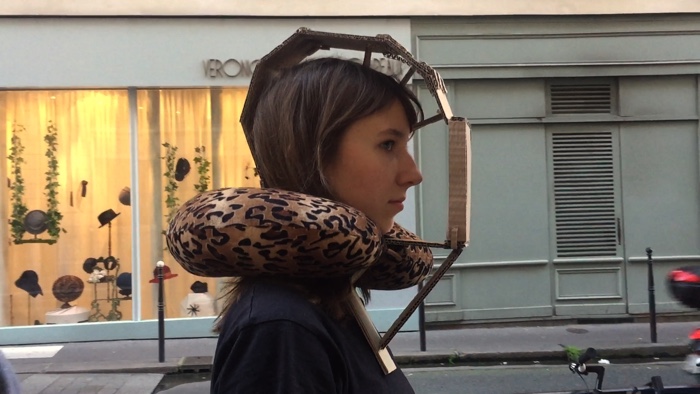
Center for Technological Pain, Handsfree headset to liberate the users hands
Center for Technological Pain, Tranquility Cube
In these cases and many others, the Center for Technological Pain has the solution for you. Dasha Ilina, the CEO of the company, designed a series of stunning prototypes that promise to cure your tech-related ailments and even prevent them from appearing.
Instead of selling the miraculous contraptions at the high price they command, Ilina graciously offers small manuals that explain how to build them yourself using affordable materials.
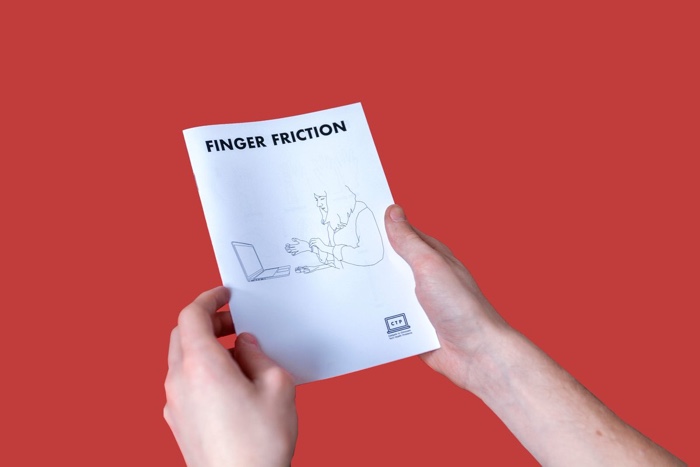
Center for Technological Pain, Friction-Free Gloves leaflet
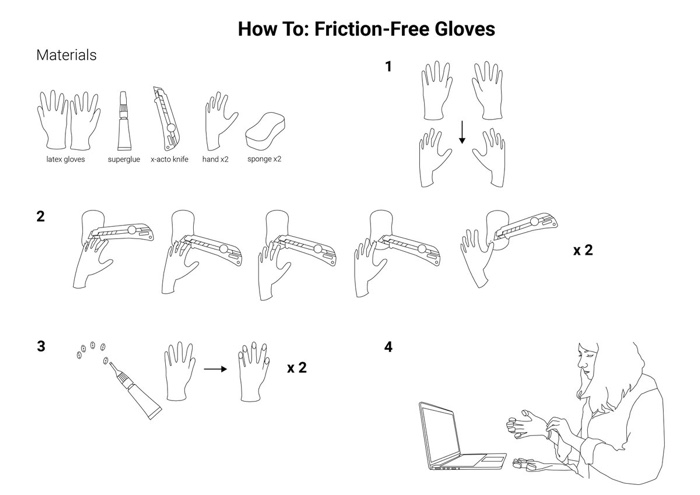
Center for Technological Pain, How To: Friction-Free Gloves
CTP even customized a series of self-defense techniques and published videos online to teach you how to help your friends and relatives battle tech addiction.
There’s obviously a lot of satire in Ilina’s work. There’s also far more sense that it might seem. After all, we’ve all seen the articles that warn us against sitting for hours in front of a laptop (some extravagantly call it “the new smoking”) or against looking down on your phone (it gives you a double chin, my dear!)
Dasha Ilina is currenty showing the CTP at the Gaîté Lyrique in Paris and this Summer she will be teaching her Self-Defense Against Technology moves at NØ School Nevers, a summer school for students, artists, designers, hackers, activists, educators and anyone who wish to engage in critical research around the social and environmental impacts of information and communication technologies.
I asked her to wear her CEO suit and give us lowdown on her promising start-up:
Hi Dasha! What i like about your project is that none of the objects you made would be useful to me (i think). Yet, the Center for Technological Pain drove me to think about the topic of health problems caused by digital technologies a lot. Whereas i would normally prefer to forget about the issue. What brought you to explore the idea of designing solutions to health problems caused by digital technologies? Did you feel there was a demand that wasn’t addressed?
I first started thinking about the relationship between health and technology when I started really looking around me and paying attention to my friends behind their desks, strangers on the streets or cafés and, in addition to that, when I heard endless complaining from my friends that spend all day behind their computers about their constant neck problems, or back pain etc. It wasn’t immediately clear to me to start creating these solutions, but I made one just to try and see what people think of it or how useful they find it. I wouldn’t say that this project was created out of a demand, per say, because I wasn’t making these objects to sell them or even to help people, at first that is.
When I first started working on CTP, it was mainly to come up with efficient, yet totally absurd objects that would serve more as a commentary, rather than design objects. Though there were moments when I considered making highly useful objects, but what’s the fun in that?
Dasha Ilina, Headset to Reduce Eye Dryness
How did you decide which objects to design? Was it the result of complains by people around you? Articles in newspapers?
A lot of the objects are results of either my own tech-pain, or of those around me. For example, the Friction-Free Gloves were a result of a complaint from a friend of mine, who told me that after working on her laptop with the trackpad all day and swiping on her phone, she feels discomfort in her fingertips, as if they’re almost sanding away. This wasn’t anything I ever experienced but she had told me about it after I had committed to create as many solutions as time allowed, so I made the Friction-Free Gloves, which protect your fingertips with sponges. As a nice bonus, since sponges are conductive they can easily be used on a smartphone screen, though not all sponges work super well.
So I’d say about half of the problems came from personal contributions, however a lot of the objects as solutions to the same problem, such as cubital tunnel, came from research. After I’d used up all of my knowledge of tech-pain, I started reading a lot of medical articles. One of my favorite outcomes from one of those articles is the Headset to Reduce Eye Dryness. I was trying to figure out why my eyes were getting so dry and tired after working on my computer, and one of the reasons was that, when looking at a screen, our brains are so occupied with trying to decipher the information on the screen that they forget to send the signal to our eyes to blink as often as we need to. So I thought why not make an object that will put some eye drops in your eyes, in case your brain gets distracted.
Center for Technological Pain, Handsfree headset to liberate the users hands
Center for Technological Pain, Stylus Helmet to Liberate Fingers
The accessories you created for the Center for Technological Pain are ironic and a bit ridiculous-looking. Besides, the risks the project explore sound quite benign so why should we take them seriously?
The objects are quite ridiculous, I agree. They become all the more ridiculous when worn, but the problems the solutions bring up are very real and could potentially lead to serious health problems if not treated early on. With the example of cubital tunnel I read that if the patient has the syndrome and doesn’t do anything to stop putting pressure on the elbow or straining it in general, it could lead to the loss of feeling in the fingertips. Of course, I don’t know how bad someone’s state needs to be in order for it to come to that, however reading about that about a year ago really made me wonder for the first time, whether, if not the objects, then at least CTP shining a light on these health problems lots of people don’t think about could help someone, for example in a preventive way.
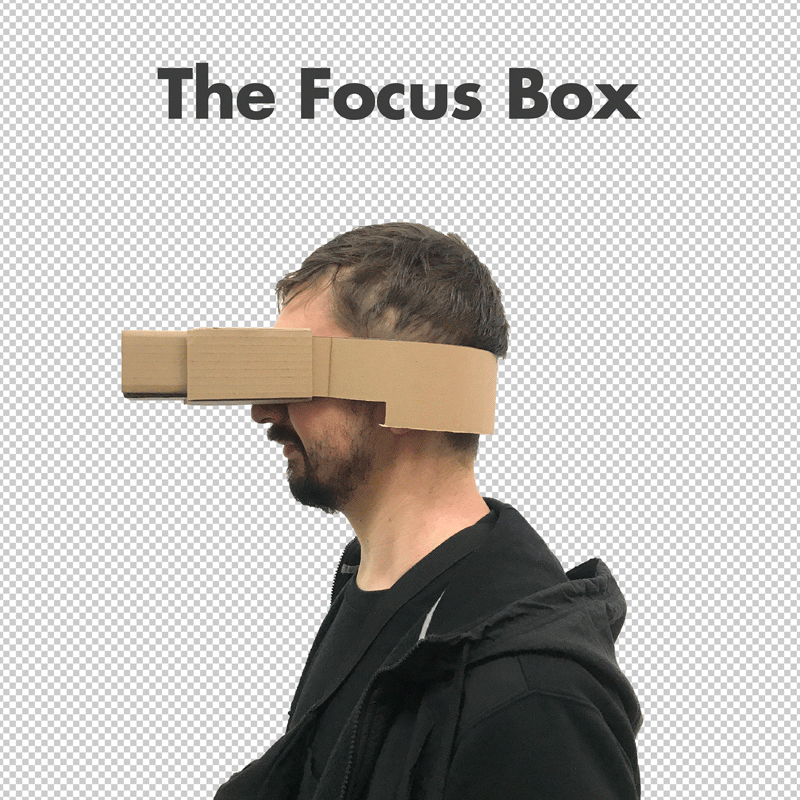
The Focus Box. Image courtesy Dasha Ilina
The CTP hosts a series of workshops aimed at empowering and educating people of all ages on the topic of technology-related pain. Do participants come with their own real or imaginary health problems and the solutions to them? Could you take us through some of the most amusing/ingenious ideas and accessories others made during these workshops?
Each session normally starts with a quick presentation of the aim of the workshop, as well as some previously made solutions, so even if the participants don’t have ideas at the beginning of the workshop they normally quite quickly come up with something. Most of the time the problems they work on are really personal, which in my opinion always makes for the most intricate solutions, because as soon as the participant realizes that they’re creating something for their own good (whether they ever use it or not), they become more engaged with the creative process, at least in my experience.
As for the most ingenious ideas there are really so many, but I will pick a few. Just a few weeks ago I hosted a workshop at the Meta Marathon in Düsseldorf, where one of the participants straight away had a very ambitious idea, but one that required him coding a software or a google chrome extension. So we took some time to think about how his idea could be translated into a physical object and eventually he decided to create this Focus Box, because he worked at a software development company where he was constantly distracted by his coworkers. When he started working on it, he told me that he had never used cardboard before and that in order to create this object he needed to first “learn the properties of the material.” He was the last participant to finish his object, but when it was done it was as well constructed as a Google Cardboard!
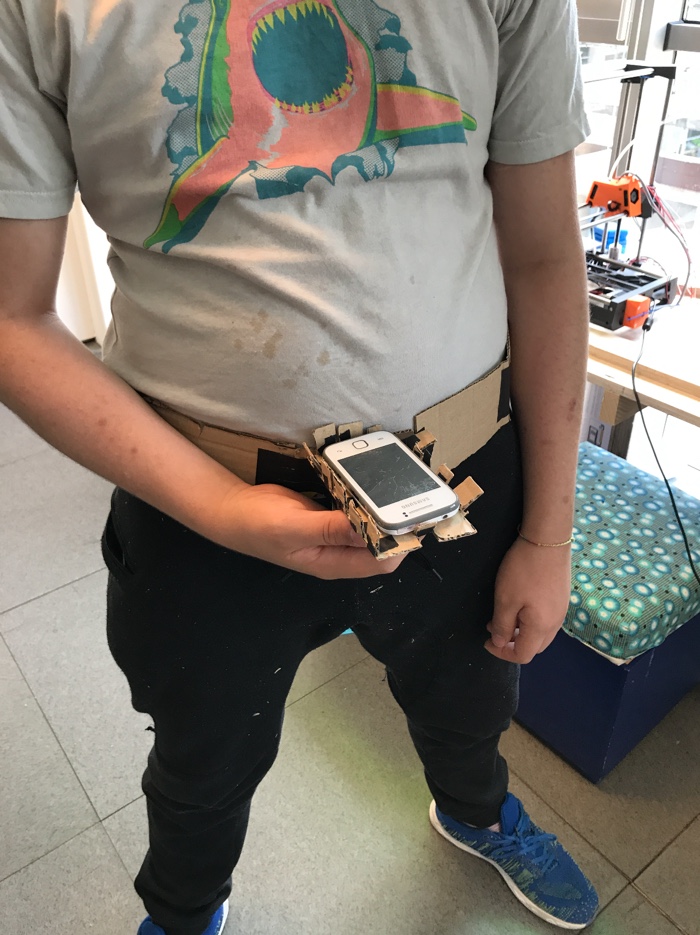
Belt for mobile phone. Image courtesy Dasha Ilina
Another object I’ll mention briefly was created by a younger participant (around 12 year old) during a workshop at Le Cube. He was clearly quite advanced in the topic of tech-pain, because without hesitation he chose to work on the electromagnetic waves emitted by the cellphone, which could cause damage to the brain. As a solution to this problem, he created a belt in which you would place your phone in order to keep it as far away from your head as possible. I thought it was a great idea, which is why I decided to not bring up the problems that can arise from the placement a phone next to one’s genitals.
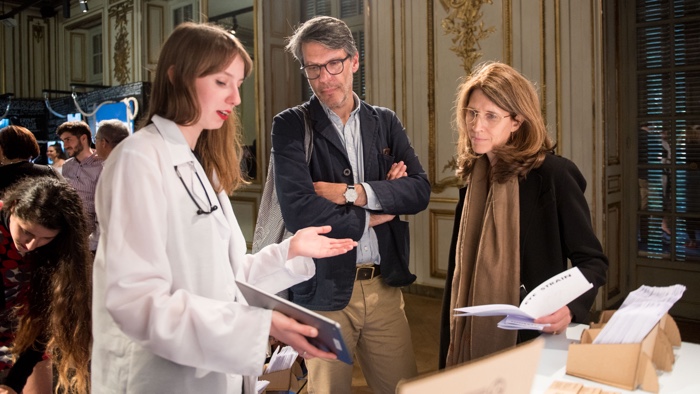
A CTP demo. Photo credit: Julien Mouffron-Gardner
All the objects in the collections are as no-tech as can be. Only the “Eye strain reducing glasses” rely on technology. Does that mean that sometimes the only solution to a problem caused by tech is to throw more technology at it?
Maybe! Those glasses were actually the first object I created, so I’m not sure if that could be a reason why it’s the only one that involves tech. I’ve tried thinking about how the same solution, meaning something that forces the user to take a break from the screen, can be performed in a different, no-tech way. I don’t have a good idea just yet, but I think that the best way to achieve the same result would be through a self-defense move, one that would require your partner to karate chop your computer so that it closes therefore forcing you to look up from your screen.
Self Defense Techniques Against Technology
I tried some of your Self-defense moves against technology on my boyfriend. Sleep Defense is a favourite of mine. It never goes down very well though. Why did you make these moves so aggressive and unpleasant for the receiver of these tactics?
That’s great to hear, I’m glad you’re enjoying the moves! They are very aggressive and I do always try to make the point that they could hurt someone. But the reason they are that way is because I did not make them up. All of the self-defense against technology moves are based on real self-defense moves, so of course the tactics come from methods of protection and survival, they are meant to be unpleasant and in their real application they are meant to hurt the other person involved.
You grew up and studied in Russia and then in the USA and now you live in Paris. Have you observed different types of tech-related pains and solutions from country to country? Do people have different ways to misuse and harm themselves with tech in France than in Russia or the US for example?
That’s a great question, of course I wasn’t thinking about tech-pain back when I was living in Russia and the US, so to answer I will have to go off my memories. Something that becomes really problematic in Russia during the winter is the need to use your phone on the street when its -15 degrees outside mixed with the wish to look cool and not wear gloves. Of course on the other side, most of the times (at least with iPhones) when you take your phone out when it’s that cold it just refuses to turn on, so I guess Apple presented us with a solution of their own.
As for the US, the first thing that comes to mind is a very popular, yet very serious problem of texting and driving. I don’t know if percentage wise more people text and drive in the US compared to France and Russia, but the truth is that everyone drives in the US, so it does become a big problem, even if a small percentage of the population does it. When it comes to texting and driving, aside from the obvious safety problems that it causes, which could lead to car crashes, it’s also terrible for the drivers neck, as most often than not it requires constantly looking down. In addition to that, I imagine that it’s also very uncomfortable for the hand that is performing the texting, especially the thumb.
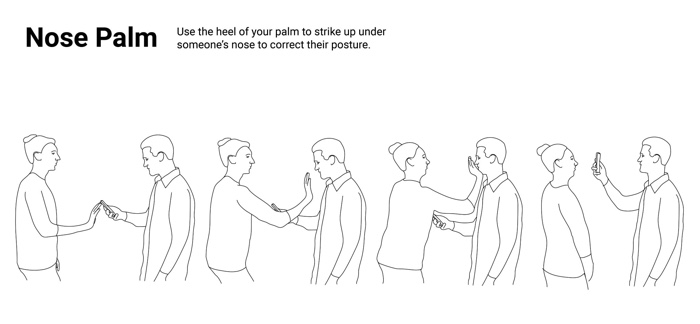
CTP, The Nose Palm move
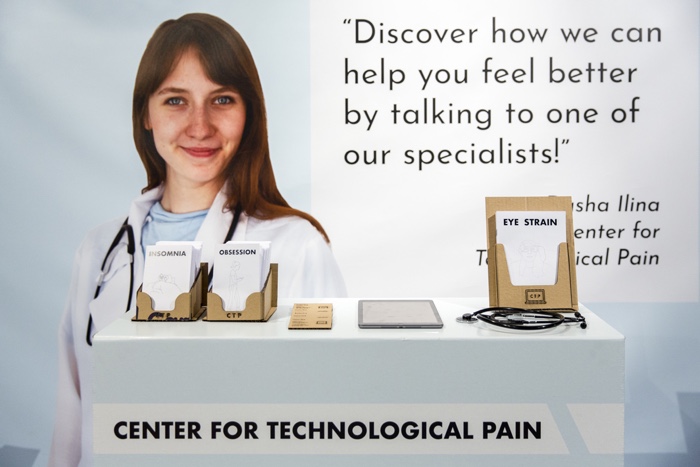
Any upcoming event or field of research you’d like to share with us?
Yes! There is one event coming up this summer I am particularly excited about, which is NØ School Nevers. It’s an Art and Technology Summer School in Burgundy in France that is organized by one of my former teachers, Benjamin Gaulon. I will be giving a Self-Defense Against Technology class, but besides me there are 29 other artists/hackers/researchers, etc. who will be giving workshops, lectures, performances and more. And if you would believe it there are still some places available to be able to participate in this 2 week long summer program!
Thanks Dasha!
NØ School Nevers, is a unique international summer school, held in Nevers in Burgundy for students, artists, designers, makers, hackers, activists and educators who wish to further their skills and engage in critical research around the social and environmental impacts of information and communication technologies. 1-14 July in Nevers, France.
The Center for Technological Pain is also participating to the show Computer Grrrls. History, Gender, Technology, curated by Inke Arns and Marie Lechner. The exhibition remains open until at the Gaîté Lyrique in Paris until 14 July 2019.
